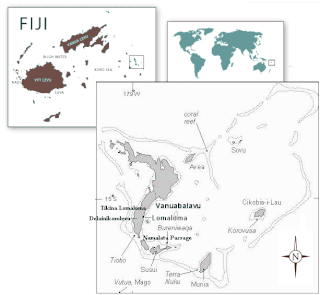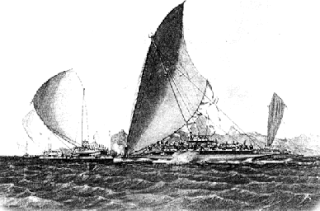Related Research Articles

Articles about people, places, things, and concepts related to or originating from Fiji, include:

RoLala, Lady Mara, maiden name Litia Cakobau Lalabalavu Katoafutoga Tuisawau was a Fijian chief, who was better known as the widow of Ratu Sir Kamisese Mara, modern Fiji's founding father who served for many years as Prime Minister and President of his country. As Fiji's First Lady, Adi Lala took on a diplomatic role, frequently representing her country abroad. She was regarded as a formidable and astute woman, whose influence on her husband was said to be considerable.
Ratu is an Austronesian title used by male Fijians of chiefly rank. An equivalent title, adi, is used by females of chiefly rank. In the Malay language, the title ratu is also the traditional honorific title to refer to the ruling king or queen in Javanese culture. Thus in Java, a royal palace is called "keraton", constructed from the circumfix ke- -an and Ratu, to describe the residence of the ratu.
The House of Chiefs in Fiji consists of the Fijian nobility, composed of about seventy chiefs of various ranks, majority of which are related. It is not a formal political body and is not the same as the former Great Council of Chiefs, which was a political body with a prescribed constitutional role, although the membership of the two bodies did overlap to a great extent.

ʻEnele Maʻafuʻotuʻitonga, commonly known as Maʻafu, was a Pacific islander who held important titles in two countries in the Pacific. He was a traditional Tongan Prince and a Fijian chief nominated and installed by the Tovata chiefs of Lakeba and Vanua Balavu as 'Tui Lau' in 1869. This title was ratified by a wider council of Fijian chiefs and subsequently formalised under British colonial administration. In 1847, Maʻafu went to Fiji in an expedition to Vanua Balavu to investigate the killing of a preacher.
The culture of Fiji is a tapestry of native Fijian, Indian, European, Chinese, and other nationalities. Culture polity traditions, language, food costume, belief system, architecture, arts, craft, music, dance, and sports will be discussed in this article to give you an indication of Fiji's indigenous community but also the various communities which make up Fiji as a modern culture and living. The indigenous culture is an active and living part of everyday life for the majority of the population.
The Vuanirewa is the ruling tribe (yavusa) of the Lau Islands, a scattered group of more than a hundred islands and reefs along the eastern edge of Fiji.

Moala is a volcanic island in the Moala subgroup of Fiji's Lau archipelago. It has an area of 62.5 square kilometers (24.1 sq mi), making it the ninth largest island of Fiji. The highest point on the island of Moala, at a maximum elevation of 468 meters (1,535 ft), is called Delaimoala which has rich vegetation and consists of dark thick forest. The population of around 3000 live in eight villages. The chief village of Naroi, whose population is over 500, was formalised during the colonial era to entertain those that would not be entertained elsewhere. Economic activities include coconut farming, cocoa production, fishing and yaqona (kava) production.
Nasaqalau is one of the eight villages on the island of Lakeba, in Fiji's Lau archipelago. The Yavusa Naseuvou includes four mataqalis, namely Dreketi, Loma, Nakabuta and Nautoqumu. Nasaqalau was also home to the first settlers on the chiefly island who were led by the Tui Lakeba as he continued his search for new land from Wainikeli in Taveuni.

Lomaloma is a village at the south of the island of Vanua Balavu in the Lau archipelago of Fiji. The settlement is part of the tribal district of Tikina, Lomaloma and consists of 9 villages, 13 Yavusa (tribes), 42 Mataqali (clans), and 54 family units known as Tokatoka. The nine villages of Lomaloma Tikina are Lomaloma, Sawana, Susui, Narocivo, Namalata, Uruone, Levukana, Dakuilomaloma, and Tuvuca.
Ratu Alifereti Finau was the eleventh Sau ni Vanua of Lau and the fifth Tui Nayau. He was a member of the noble household Matailakeba.
Sau Mai Kedekede now more commonly referred to as Sau ni Vanua ko Lau is one of the preeminent titles held by the Paramount Chief of the Lau Islands in Fiji.

Turaga na Rasau is a traditional Fijian chiefly title of the Lau Islands. Prior to Fiji's colonial days, Fiji had many different Vanua with their own Paramount Chieftain which exercised no authority over the other; a saying from the island of Kadavu aptly summarises it "Nomu Turaga o sega na noqu Turaga" or "Your Chief is not my Chief" also the people of Beqa Island were of a similar opinion saying "Qali Cuva Ki Lagi" or "Subject only to heaven" and would bow to no outside Chieftain, but at the turn of the 20th century aspects of the traditional social structure remained, but for administrative purposes three main Matanitu were solidified and formed as they were the dominant consolidated powers at the time being that of Kubuna, Burebasaga and Tovata. With regard to the Rasau while its traditional origins were in Kubuna on Bau the titles traditional authority in modern Fiji is now in Tovata, Lau in particular Lomaloma Tikina on the Island of Vanua Balavu.
Taukei ni Waluvu is a Fijian phrase for "Owner of the Flood." It is the traditional chiefly title of the warrior hill clan Siko-Natabutale of Nairukuruku village. The history of the clan from the mid- nineteenth century, represent the social structures of the chiefly system, religion and western culture that supported colonialism in Fiji. Tradition, Christianity and British indirect rule were combined to legitimize what was accepted as the right way to govern. Condemned by some modern day critics as exploitative, the Fijian chiefly system was the medium of native social interdependence and a traditional contract shared by the indigenous clans of pre-colonial Fiji, that was utilized for colonial rule. Since Independence the chiefly system has had to adapt to the demands of modernity. Anthropologist Arthur Capell in his study of early tribal migration within Fiji made the point that, "the history of Fiji is the history of chiefly families." The phrase in fact emphasized the hierarchical nature of Fijian traditional society where chiefly power was held sacred. The relationship between Chiefs and Westerners in especially Missionaries thus became a focal point for gathering insight into Fijian culture and tradition in the nineteenth century. James Turner a latter anthropologist found, "The chiefly families of Nairukuruku were the first in the eastern highlands of Viti Levu to declare their allegiance to the central government and as a result of this support their influence expanded throughout the area".

The Lasakau Sea Warriors were a 19th-century warrior sub-culture in the pre-colonial state of Bau, in Fiji. The sea warriors were instrumental in spreading Bau's political power throughout the South Pacific archipelagic islands. The rise of the eminent islet of Bau amongst other embryonic states was due mainly to the projection of sea power through its naval forces. Bauan chief Ratu Loaloadravu Tubuanakoro was praised by French Captain Dumont D'Urville in May 1827 for his geographic knowledge of the Fijian archipelago signifying Bau's naval influence. More far-ranging than Bau's land warriors led by the Vusaradave clan, the Lasakau clan became the leading proponents of war and tribute for the emerging island kingdom. They became known as the Bai kei Bau or 'War fence of Bau'. Sahlins made the crucial observation that," The kings of Bau based their rule not on native cultivators but on native sailors and fishers-which is to say in Fijian categories, as in political strategies, not on the land but on the sea". This was the great political transformation that catapulted Bau to power over other pre-colonial kingdoms.
Lauwaki is the second largest village in the Vuda district, Ba Province in the Western side of Viti Levu, Fiji.

Verata is a tikina in Fiji's Tailevu Province. It is made up of several sub-districts or Tikina makawa, namely: Verata, Namalata, Tai, Vugalei, and Taivugalei.
In Fiji, Turaga na Roko Tui Bau is a vassal chief of the Vunivalu of Bau. From his seat at the residence of Naicobocobo, the Roko Tui Bau rules the Vusaratu chiefs and has relationships with the Roko Tui Dreketi, Ratu Mai Verata, Roko Tui Namata, Roko Tui Veikau, Tui Vuya and other members of Fiji's House of Chiefs.

Viwa Island, Yasawa is located approximately 70 km northwest of Denarau situated in the Yasawa Islands of Fiji.

Navatu is a sub district in Cakaudrove; one of 3 provinces situated in Vanua Levu, the second largest island in Fiji. The sub-district, or "tikina" as it is known in the iTaukei language, comprises nine villages mainly occupying the eastern peninsular of the Natewa Bay. While Copra has been the main source of income for villages in the Navatu tikina, kava or yaqona is also becoming a fast growing commodity for villages within the Navatu sub-district.
References
- Marshall Sahlins, Islands of History, University of Chicago Press, 1987, p. 87. Details in the terms Liga ni Magiti and Liga ni Wau, among other details on Fijian social structure.
- The Journal of General Psychology, By Edward Bradford Titchener, Contributor Edward Bradford Titchner, Carl Allanmore Murchison, Journal Press, 1928. Details on the term Tauvu and the cross tribal relationship.
- Oceania, Australian National Research Council, University of Sydney, 1930. Details on the Yavusa and its composition.
- Ethnology, University of Pittsburgh, 1962, pp. 353—58. Details on the Yavusa and Matagali.
- Martha Kaplan, Neither Cargo Nor Cult: Ritual Politics and the Colonial Imagination in Fiji, Duke University. Details on Fijian social structure and hierarchy.
- Asesela Ravuvu, A., The Fijian Way of Life. Suva, Fiji: University of the South Pacific, 1983.
- Man, Royal Anthropological Institute, 1901, p. 223. Details on the Tako Lavo, inter-tribe father-son relationship. Also reference in Oceania, Australian National Research Council, University of Sydney, 1930, p. 194.
- William Halse Rivers Rivers, The History of Melanesian Society, 2000, pp. 183—85. Details on the cross cousin relationships and terms used.
- Anne E. Becker, Body, Self, and Society: the view from Fiji, 1995, p. 23. Details of various kinship and cross tribal terms and relationships.
- Chris Gosden, Jon G. Hather, The Prehistory of Food: Appetites for Change, pp. 272—75. Details of the Matagali, yavusa and Matanitu.
- Maryon Macdonald, Gender, Drink and Drugs, pp 153—56. Details on Yaqona its recent history its ceremonial and social use.
- Tim Bayliss-Smith, Brian Robson, David Ley, Derek Gregory (eds), Islands, Islanders and the World: The Colonial and Post-Colonial Experience of Eastern Fiji, pp. 47—51. Details on Matanitu, Yavusa and other aspects of Fijian social structure.
- Karen J. Brison, Our Wealth Is Loving Each Other: Self and Society in Fiji. Details on the Tabua and its role and value in traditional presentation.
- Nicholas Thomas, Entangled Objects: Exchange, Material Culture, and Colonialism in the Pacific, p. 67. Details on ceremonial items and its value and importance in ceremony.
Translations and transliterations
- Albert James Schütz, Say it in Fijian, An Entertaining Introduction to the Language of Fiji, 1972.
- Paul Geraghty, Lonely Planet Fijian Phrasebook, 1994, 182 pp.
- Rusiate T. Komaitai, Albert J. Schütz, Contributor Rusiate T Komaitai, Spoken Fijian: An Intensive Course in Bauan Fijian, with Grammatical Notes and Glossary, 1971, University of Hawaii Press, Foreign Language / Dictionaries / Phrase Books, ISBN 0-87022-746-7.